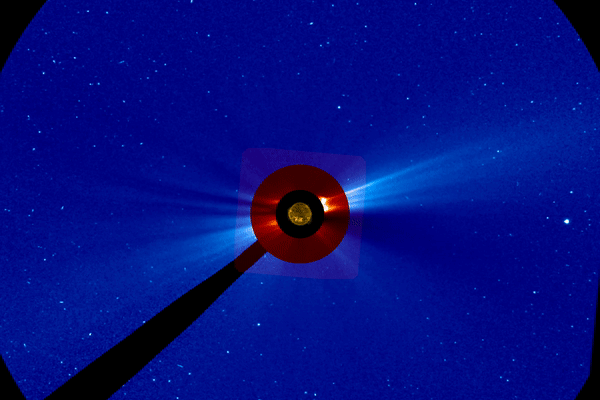Let’s talk about heliophysics!
Don’t worry, we were intimidated too. That’s why we talked with Jarrod Bianco and Maile Marriott, two graduate students working with Anna Tenerani, an assistant professor in the Department of Physics in the College of Natural Sciences at The University of Texas at Austin. They helped us understand some of the critical details around solar winds and the sun’s corona, two of the most important subjects in heliophysics (which we learned is the study of the sun and how it influences Earth and the bodies in our solar system). Bianco and Marriott, along with countless other physicists inside the Great North American Eclipse’s path of totality, will have a unique opportunity to study these features during the upcoming eclipse.
During a solar eclipse, the sun’s corona is the fiery ring you can see flaming out around the blocked-out sun (but only while, we feel compelled to remind you, wearing your ISO-approved eclipse glasses!). This corona presents one of the biggest mysteries in our research on the sun. While the surface of our star is about 10,000 degrees Fahrenheit, temperatures in the corona can soar up to millions of degrees. “My advisor once put it this way,” Marriott said. “It’s like a pot of boiling water sitting on top of an ice cube.”
While we don’t know exactly why the corona is so hot, we do know lots of things about how important that temperature is. For one, the high temperature of the solar corona is responsible for the solar wind that blows out towards earth and into the rest of the solar system. These solar winds interact directly with the Earth and its magnetosphere, cutting through it like a boat trailing through water.
The effects of solar winds blasting out from the sun’s corona are ripe for further research, from the beautiful — the aurora borealis is caused by solar winds interacting with our atmosphere — to the dangerous. Marriott’s and other’s work to understand solar wind phenomena could lead to greater predictive accuracy for these events. Solar weather events can disrupt satellites (both during launch and once they are in space) and interfere or amplify radio signals. The catastrophic electromagnetic pulses that can accompany a really big coronal mass ejection could even wreak havoc on our electrical infrastructure.
In order to protect our national electricity grid and everything it powers — like the internet — we need to know more about these events. “Why do these winds exist in the first place?” Marriott asks. “The answers might just help prevent Armageddon.”

We also asked Bianco and Marriott if there’s anything particularly exciting about 2024’s Great North American Eclipse. The increase in missions out there right now looking at the sun is a big one, Bianco said.
“There’s the Parker Solar Probe and the Solar Orbiter — even the Voyager probes of Carl Sagan’s golden record fame spent a lot of time looking at the sun,” he said. “These missions help us get empirical results that we can compare to what we find in our theories and simulations.”
Marriott added, “Every 11 years, the sun goes through a cycle of high and low activity. This eclipse is happening at the peak of the cycle, so we hope to get data from a lot of really cool events happening on the sun that’ll give us new insights into physics.”
Beyond the astonishing science we’ll get to conduct during this once-in-a-generation phenomenon, the inspirational and emotional impact of this event might be even grander.
“This has the potential to be really awe-inspiring, especially for kids with eclipse glasses and telescopes who might have inclinations toward studying the universe,” Bianco said. “Being able to look at the sun the way you look at the moon really helps quantify it as an actual real, giant thing in the sky.”
“This is the second major eclipse I’ve experienced at a university where I’m studying heliophysics,” Marriott said, telling us about a recent path of totality that crossed over the university where she studied at the time. Then, posing a thought many of us have had while looking up at the big, infinite sky: “I feel like my life is aligned to the stars.”




